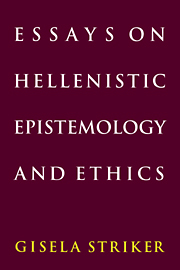Book contents
- Frontmatter
- Contents
- Preface
- Acknowledgments and essay sources
- List of abbreviations: Frequently cited names and titles
- EPISTEMOLOGY
- 1 Methods of sophistry
- 2 Kριτήριον τῆς ἀληθείας
- 3 Epicurus on the truth of sense impressions
- 4 Sceptical strategies
- 5 The Ten Tropes of Aenesidemus
- 6 On the difference between the Pyrrhonists and the Academics
- 7 The problem of the criterion
- ETHICS
- Name index
- Index of passages cited
5 - The Ten Tropes of Aenesidemus
Published online by Cambridge University Press: 05 June 2012
- Frontmatter
- Contents
- Preface
- Acknowledgments and essay sources
- List of abbreviations: Frequently cited names and titles
- EPISTEMOLOGY
- 1 Methods of sophistry
- 2 Kριτήριον τῆς ἀληθείας
- 3 Epicurus on the truth of sense impressions
- 4 Sceptical strategies
- 5 The Ten Tropes of Aenesidemus
- 6 On the difference between the Pyrrhonists and the Academics
- 7 The problem of the criterion
- ETHICS
- Name index
- Index of passages cited
Summary
The Ten Tropes of Skepticism are, as histories of philosophy tell us, a systematic collection of all or the most important arguments against the possibility of knowledge used by the ancient Pyrrhonists. The list of eight, nine, or ten “tropes,” or modes of argument, presumably goes back to Aenesidemus, the reviver of the Pyrrhonist school in the first century B.C. Very little is known about Aenesidemus as a person. He seems to have lived in Alexandria (Aristocles ap. Eusebius, Praep. ev. XIV 18. 22). Photius tells us (Bibl. Cod. 212) that he dedicated a book to a “fellow Academic,” the Roman L. Tubero, and this may indicate that he started off as a student of the skeptical Academy, but later decided to argue for a different form of skepticism associated with the name of Pyrrho. From Photius's account it appears that he may have been dissatisfied with the dogmatic turn the Academy seemed to take during his lifetime, and hence decided to appeal to the more or less mythical founder of the skeptic movement. We do not know how he became acquainted with the Pyrrhonist tradition, nor whether his collection of arguments had any predecessor; but since later authors tend to associate the list of Tropes with his name, it seems likely that he was the first who tried to present a systematic repertoire of Pyrrhonist arguments.
- Type
- Chapter
- Information
- Essays on Hellenistic Epistemology and Ethics , pp. 116 - 134Publisher: Cambridge University PressPrint publication year: 1996
- 5
- Cited by



